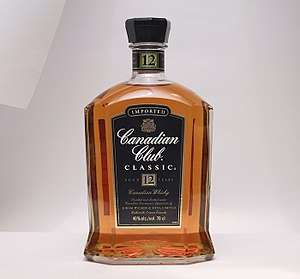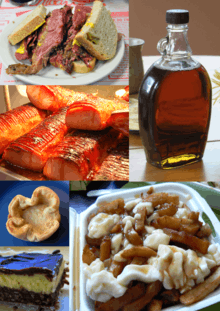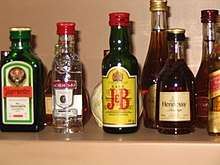Canadian whisky

 |
| Part of a series on |
| Canadian cuisine |
|---|
|
Regional cuisines |
|
Styles and dishes
|
|
Religious and ethnic |
|
Canadian whisky is a type of whisky produced in Canada. Most Canadian whiskies are blended multi-grain liquors containing a large percentage of corn spirits, and are typically lighter and smoother than other whisky styles.[1] When Canadian distillers began adding small amounts of highly-flavourful rye grain to their mashes, people began demanding this new rye-flavoured whisky, referring to it simply as "rye". Today, as for the past two centuries, the terms "rye whisky" and "Canadian whisky" are used interchangeably in Canada and (as defined in Canadian law) refer to exactly the same product, which generally is made with only a small amount of rye grain.[2]
Characteristics
While the lighter and smoother Canadian whiskies are the most widely familiar, the range of products is broad and includes some robust whiskies.[1][3][4]
Historically, in Canada, whisky that had some rye grain added to the mash bill to give it more flavour came to be called "rye".[5] Although some Canadian whiskies are still labelled as "rye", Canadian "rye" whisky usually contains high-proof grain whisky blended with lower-proof rye-grain whisky and Canadian-made "bourbon-style" corn whisky as flavouring. Occasionally barley whisky is also used for flavouring. Flavour may also be derived in other ways, such as flavour development from the aging process.[5] It is a common misconception that Canadian whiskies are primarily made using just rye grain.[1] The use of rye grain is not dictated by law,[6] and the primary grain used to make most Canadian whisky is corn.
History
Grain distilling methods and technologies were brought to Canada by American and European immigrants. While rum was the primary alcoholic product distilled in the cities, a result of access to sugar from British colonial plantations, excess grain being harvested in the rural areas was distilled in small batches. The first commercial scale production of whisky in Canada began in 1801 when John Molson purchased a copper pot still, previously used to produce rum in Montreal. John's son Thomas took an interest in producing whisky, first in the Molson distillery then independently in Kingston from 1821 to 1834 but left it to James Morton as the family focused on their brewery. Molson, the largest distillery in Canada at the time, had exported most of this early whisky to Britain where tastes were shifting away from French wine and brandies to whiskies as a result of the Napoleonic Wars. Gooderham and Worts began producing whisky in 1837 in Toronto as a side business to their wheat milling but surpassed Molson's production by the 1850s as it expanded their operations with a new distillery in what would become the Distillery District. Henry Corby started distilling whisky as a side business from his gristmill in 1859 while American Hiram Walker opened a flour mill and distillery in Windsor in 1858. American J.P. Wiser moved to Prescott in 1857 to work at his uncle's distillery in 1857 where he introduced a rye whisky and was successful enough to buy the distillery five years later. The disruption of American Civil War created an export opportunity for Canadian-made whiskies and their quality, particularly those from Walker and Wiser who had already begun the practice of aging their whiskies, sustained that market even after post-war tariffs were introduced.[7] Corby's son, Henry Jr. took over in 1881 as a favourable regulatory environment emerged for Canadian whiskies: Canada's National Policy placed high tariffs on foreign alcoholic products, whisky began to be sold in bottles, and in 1883 the federal government instituted a bottled in bond program to allow deferral of taxes on whiskies as they aged, which encouraged aging.[8]
Illicit export to the United States
Canadian whisky featured prominently in rum-running into the U.S. during Prohibition. Hiram Walker's distillery in Windsor, Ontario, directly across the Detroit River from Detroit, Michigan, easily served bootleggers using small, fast smuggling boats.[9][10]
Regulations
Canada's Food and Drugs Act require that whisky labelled as "Canadian Whisky", "Canadian Rye Whisky" or "Rye Whisky" be mashed, distilled and aged at least three years in Canada.[6] As with Scotch whisky and Irish whiskey, the alcohol content of the spirits used may exceed 90%.[6][11] Thus, much of the spirits used in making a Canadian whisky, prior to aging, may have less grain-derived flavour than typical single malts or U.S. "straight" whiskeys. To improve marketability, it may contain caramel colour and flavouring, in addition to the distilled mash spirits.
All spirits used in making a Canadian whisky must be aged for at least three years in wooden barrels of not greater than 700 litre capacity (a requirement similar to that for Scotch and Irish whisky and longer than for American whisky).[12] The final whisky must contain at least 40 percent alcohol by volume.[6][13] No distinction is made between the quality of the barrels – new or used, charred or uncharred barrels may be filled for aging.
Labelling
Canadian whisky is recognized internationally as an indigenous product of Canada. Products labelled as Canadian whisky in the United States must satisfy the laws of Canada that regulate the manufacture of Canadian whisky for consumption in Canada.[14] When sold in another country, Canadian whisky is typically also required to conform to the local product requirements that apply to whisky in general when sold in that country, which may in some aspects involve stricter or less stringent standards than the Canadian law.
Whisky brands
References
- 1 2 3 What is Canadian Whisky?, whisky.com. (Access date December 15, 2010.)
- ↑ de Kergommeaux, Davin (2012). Canadian Whisky: The Portable Expert. McClelland & Stewart Ltd. pp. xii & 5. ISBN 978-0-7710-2743-7.
- ↑ Canadian Whisky. "Wiser's Legacy Canadian Rye Whisky". Canadianwhisky.org. Retrieved March 2, 2011.
- ↑ CanadianWhisky.org. "Whistlepig 10 Year Old Straight 100% Rye Whisky". Canadianwhisky.org. Retrieved March 2, 2011.
- 1 2 CanadianWhisky.org. "The essence of Canadian rye". The essence of Canadian rye. canadianwhisky.org. Retrieved March 2, 2011.
- 1 2 3 4 "Canadian Whisky, Canadian Rye Whisky or Rye Whisky". Government of Canada. Food and Drug Regulations (C.R.C., c. 870). Canada. Department of Justice. Retrieved 31 August 2015.
- ↑ Eby, Margaret (2015). "Canadian Whisky Makes a Big Comeback". Men's Journal. Retrieved October 12, 2018.
- ↑ Kergommeaux, Davin (2012). Canadian Whisky: The portable expert. McClelland & Stewart. ISBN 9780771027437.
- ↑ People Profile: Hiram Walker (1816–1899) Coctail Times. (Access date December 16, 2010.)
- ↑ Gary May, Rum-runner tourism helps lift the veil on 'dirty little secret' - Windsor's bootlegging past a hit with visitors and locals, MyNewWaterfrontHome.com, July 2010. (Access date December 15, 2010.)
- ↑ Scotch Whisky Association. "What is Scotch whisky?". What is Scotch whisky?. Scotch Whisky Association. Archived from the original on 23 February 2010. Retrieved March 3, 2011.
- ↑ "Standards of Identity for Distilled Spirits, Title 27 Code of Federal Regulations, Pt. 5.22" (PDF). Retrieved 2012-08-13.
- ↑ de Kergommeaux, Davin (2012). Canadian Whisky: The Portable Expert. McClelland & Stewart Ltd. p. 201. ISBN 978-0-7710-2743-7.
- ↑ Title 27: Alcohol, Tobacco and Firearms, Part 5 — Labeling and Advertising of Distilled Spirits, Subpart C — Standards of Identity for Distilled Spirits, § 5.22 — The standards of identity, U.S. Government Printing Office, current as of December 13, 2010. (Access date December 15, 2010.)


